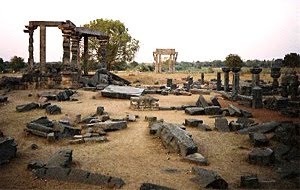Warangal - Ekasila Nagaram
Warangal Tourist Attractions, Pictures, Photos, Travel Information, Sites to See, Weather, Best time to visit, Shopping, How to Reach by Road by Train, by Air, Flight
Warangal (Telugu: వరంగల్, Hindi: वरंगल ) also known as Orugallu, and Ekasila Nagaram, one of the principal cities of South India as described by the 13th Century Venetian traveler Marco Polo, is now a bustling city of Andhra Pradesh known for its dhurrie-weaving techniques. It was the heart of Hindu Kakatiya Kings, who dominated the region until the beginning of the 14th century.
You can approach the city from any parts of the country by rail and road. The modern city and district of Warangal offer, for the spread of art, architecture and nature in the whole state. The city is a cluster of three towns Warangal, Kazipet and Hanamkonda.
History
Warangal was the capital of a Hindu Shaivaite kingdom ruled by the Kakatiya dynasty from the 12th to the 14th centuries. The old name of this newly formed city is Orugallu. Oru means one and Kallu means stone. The entire city was carved in a single rock, hence the name Orukallu meaning 'one rock' (Ekasila nagaram in Sanskrit). It was also called "Andhra Nagaram". The Kakatiyas left many monuments, including an impressive fortress, four massive stone gateways, the Swayambhu temple dedicated to Shiva, and the Ramappa temple situated near Ramappa Lake. The cultural and administrative distinction of the Kakatiyas was mentioned by the famous traveller Marco Polo. Famous or well-known rulers included Ganapathi Deva, Prathapa Rudra, and Rani (queen) Rudrama Devi. After the defeat of PratapaRudra, the Musunuri Nayaks united seventy two Nayak chieftains and captured Warangal from Delhi sultanate and ruled for fifty years. Jealousy and mutual rivalry between Nayaks ultimately led to the downfall of Hindus in 1370 A.D. and success of Bahmanis. Bahmani Sultanate later broke up into several smaller sultanates, of which the Golconda sultanate ruled Warangal. The Mughal emperor Aurangzeb conquered Golconda in 1687, and it remained part of the Mughal empire until the southern provinces of the empire split away to become the state of Hyderabad in 1724 which included the Telangana region and some parts of Maharashtra and Karnataka. Hyderabad was annexed to India in 1948, and became an Indian state. In 1956 Hyderabad was partitioned as part of the States Reorganization Act, and Telangana, the Telugu-speaking region of Hyderabad state which includes Warangal, became part of Andhra Pradesh.
 |
| Warangal - Ekasila Nagaram |
Climate:
Located in the semi-arid Telangana region of Andhra Pradesh, Warangal has a predominantly hot and dry climate. Summers start in March, and peak in May with average high temperatures in the 42 °C (108 °F) range. The monsoon arrives in June and lasts until September with about 550 mm (22 in) of precipitation. A dry, mild winter starts in late November and lasts until early February. With little humidity and average temperatures in the 22–23 °C (72–73 °F) range, this is the best time to visit Warangal.
Major Attractions
Ramappa Temple
This is located at Palampet near Mulug in Warangal district. This is of tourist importance owing to the existence of the renowned and exquisitely carved sculptures of the Ramappa Temple, and the Ramappa Lake constructed at the time of Kakatiya Ganapati. The temple, built of black basalt with splendid carvings, is 12.19 metres high. The Ramappa Lake is a magnificent irrigation work of the 13th century AD, and the place, where the lake stands, is surrounded by thick forests and presents beautiful natural scenery making it a popular holiday resort.
 |
| Ramappa Temple - Warangal |
Warangal Fort
Some of the finest forms of architecture can be seen in the ruins of this grand city. An ancient fort at the edge of the modern town tells glorious past of the city. Its striking circular plan, with three concentric rings of walls, is still intact. The outer two rings, both of mud, define a circle 1.2 km in diameter. The innermost ring is made of stone with four massive gateways at the principal points.
 |
| Warangal Fort Entrance |
 |
| Warangal Fort Inner |
 |
| Warangal Fort |
Khush Mahal
A walking distance from the fort, towards west is the Khush Mahal, an audience hall that was built by Muslim invaders in 14th century. The architecture has close resemblance with the Hindola Mahal in Mandu (Madhya Pradesh). Massive angled walls with slit windows are its main attractions. This magnificent monument now houses the idols excavated from the nearby areas.
 |
| Khush Mahal |
Hanamkonda-Thousand Pillars temple
The capital of Kakatiya rulers before they moved to Warangal is just 3 kms away from the city. A magnificent Thousand-pillard temple, dedicated to Lord Shiva, was erected here by the first Kakatiya King Rudradeva in 1163 AD. The temple is notable for its richly carved pillars, preformatted screens and exquisite icons, especially impressive are the rock cut elephants and the Nandi.
 |
| Hanamkonda Thousand Pillars Temple |
 |
| Hanumakonda Thousand Pillars Temple |
Ramappa Lake
Ramappa Lake was constructed near the Ramappa temple by Kakatiya rulers. It is a tradition in Hindu religion to construct a tank near a temple. The lake was constructed for the same reason. It holds a great scenic beauty, with its serene surroundings, giving fresh air to the temple. You can have boating facilities in the lake.
 |
| Ramappa Lake |
How to Reach
By Air: The nearest airport to Warangal is Hyderabad located 140 kms away. Flights of Indian Airlines are available from Mumbai, Bangalore, Bhubaneswar, Calcutta, Delhi and Chennai.
By Rail: Warangal is also well connected by rails with all important towns and cities of the country.
By Road: The road transport is smooth and comfortable. There are regular buses available between Warangal and Hyderabad, Yadagirigutta, Vijayawada, Armur, Kolanupaka, Jangaon, Kodad, Karimnagar, Nizamabad, Bangalore etc. The road distance between Warangal and Hyderabad is only 140 kms.


